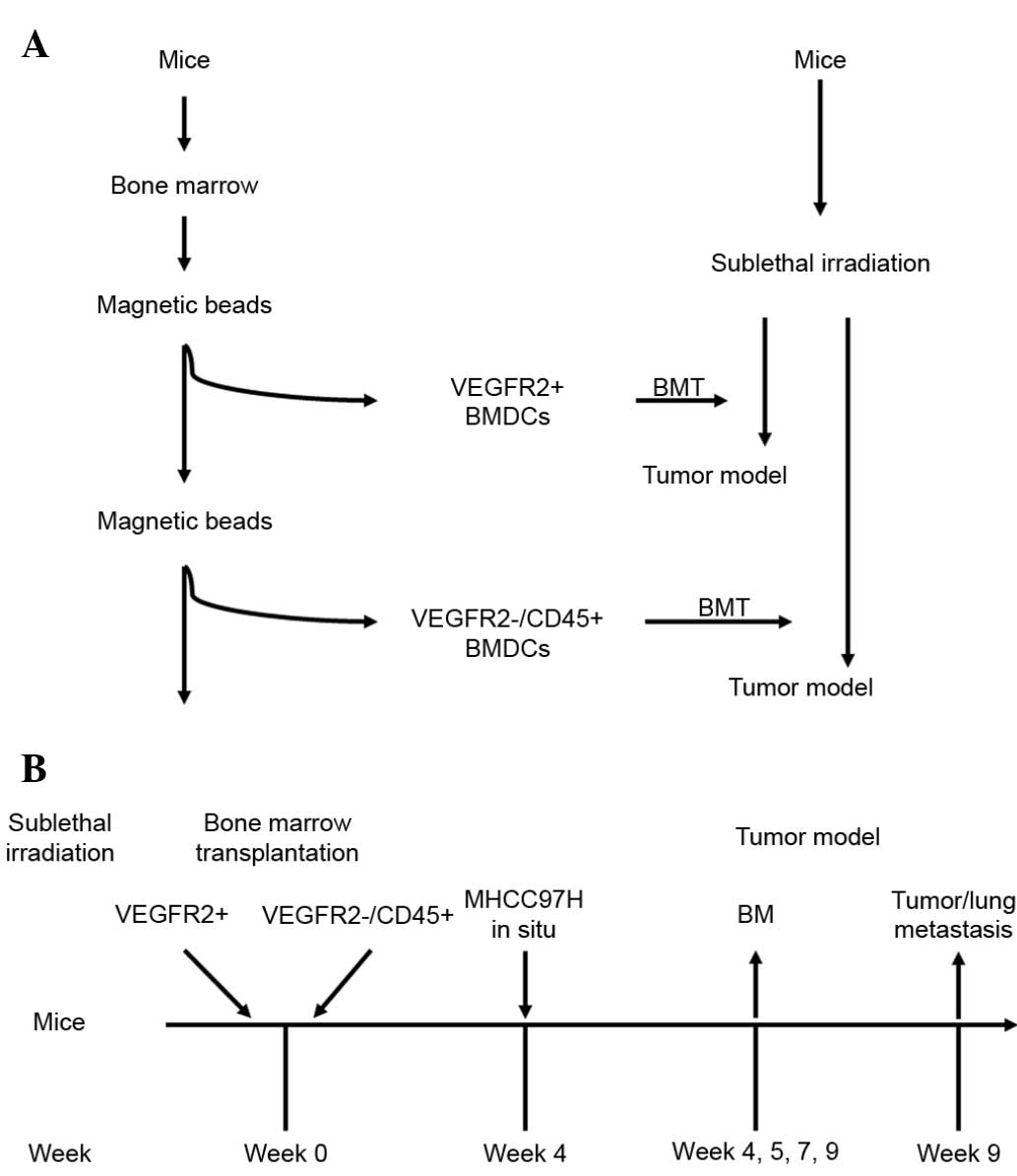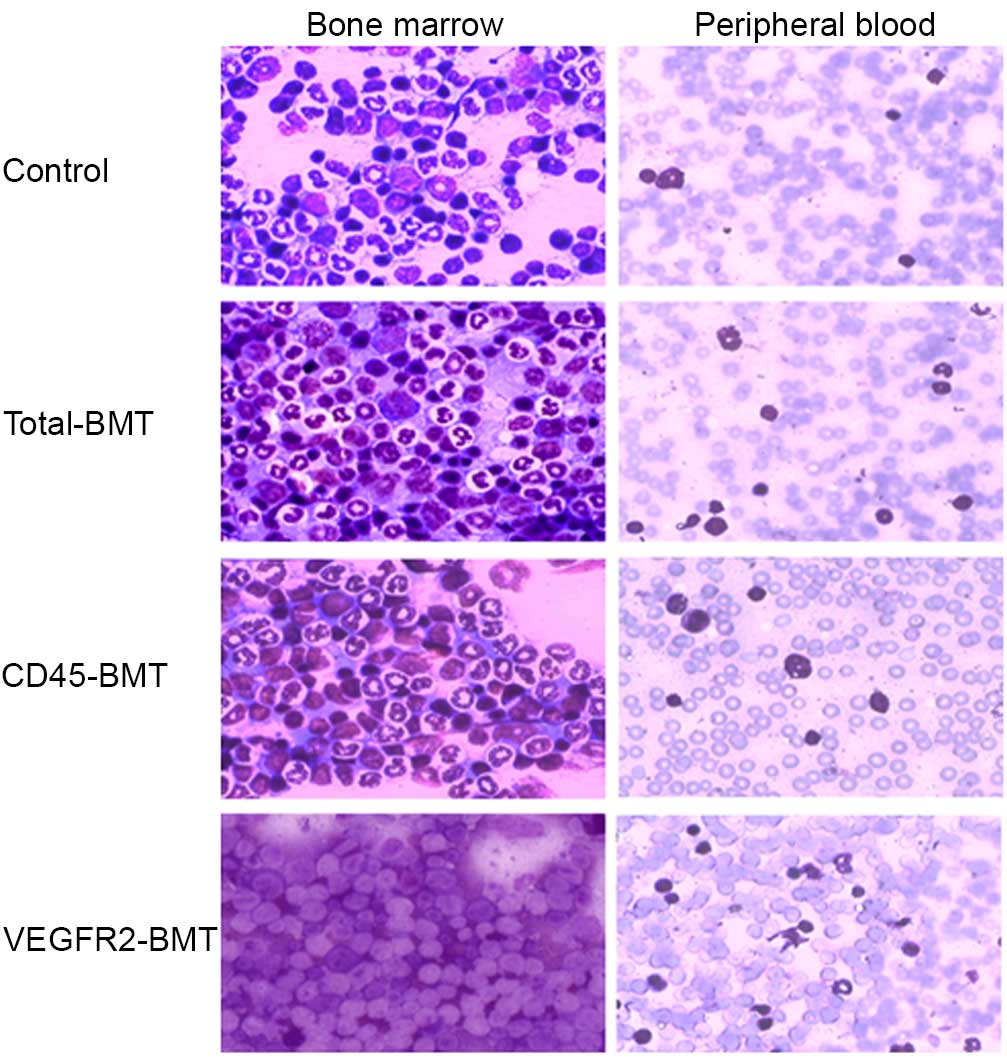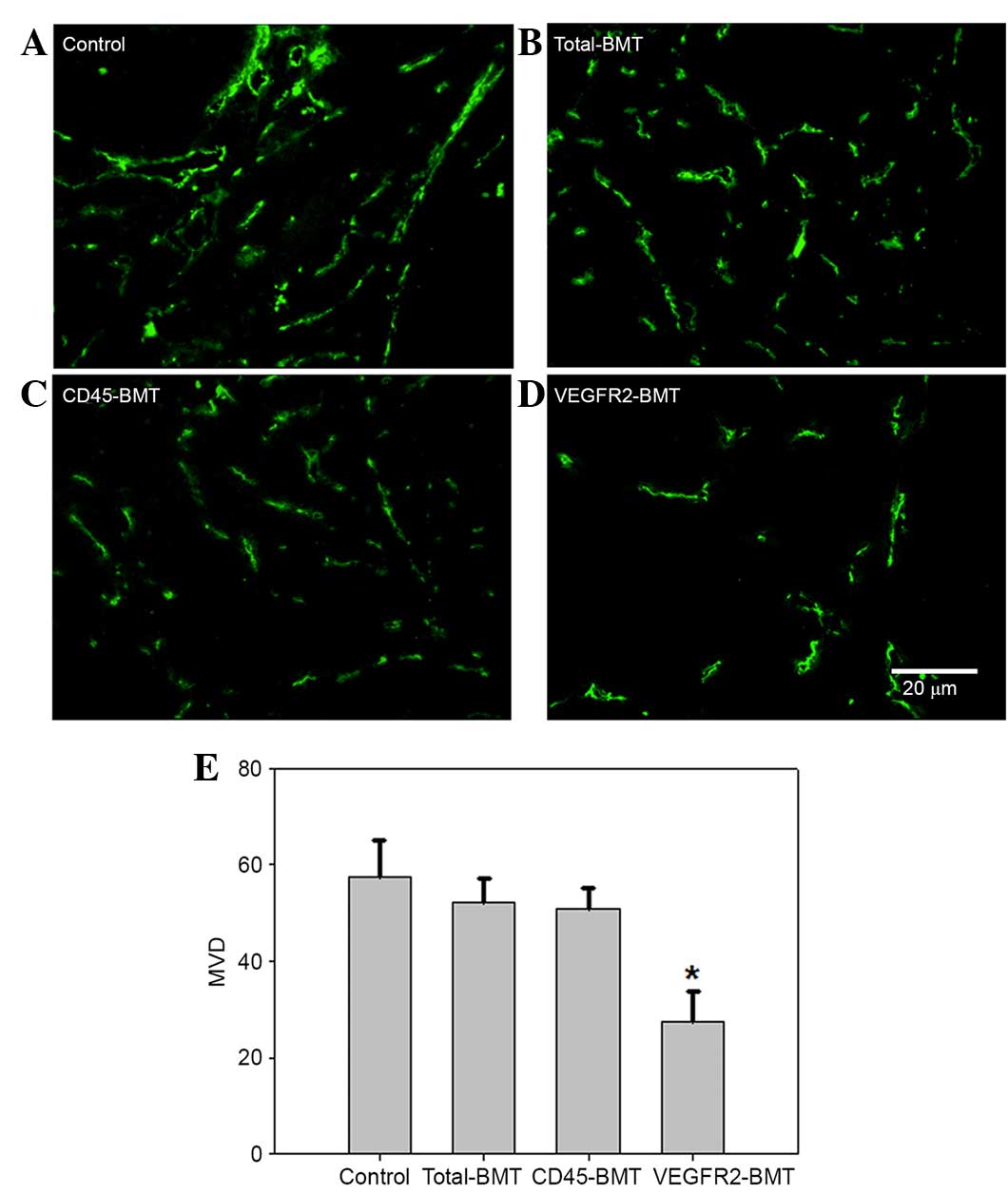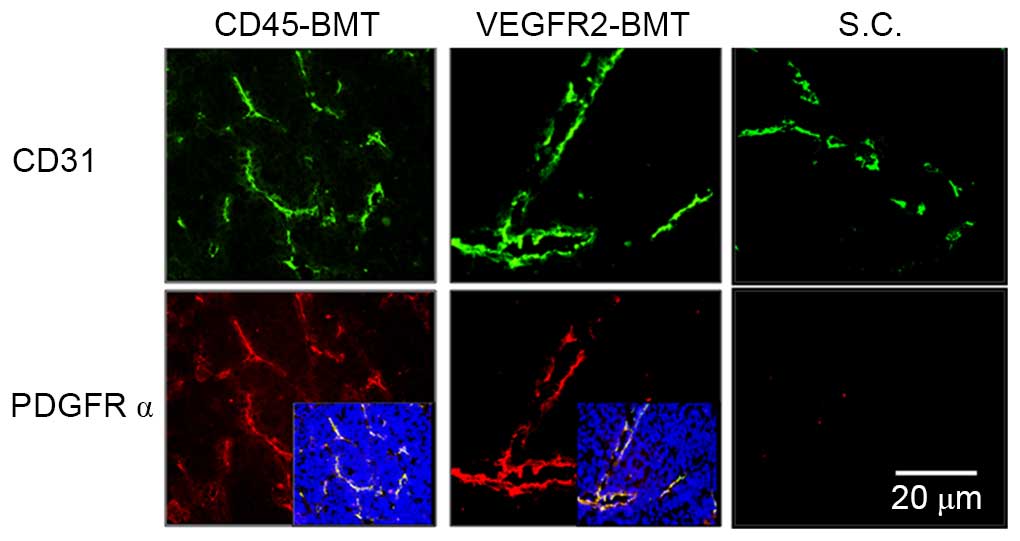Different but synergistic effects of bone marrow‑derived VEGFR2+ and VEGFR2‑CD45+ cells during hepatocellular carcinoma progression
- Authors:
- Published online on: November 22, 2016 https://doi.org/10.3892/ol.2016.5411
- Pages: 63-68
-
Copyright: © Zhu et al. This is an open access article distributed under the terms of Creative Commons Attribution License.
Abstract
Introduction
In men, liver cancer is the second leading cause of cancer-associated mortality worldwide. The majority of primary liver cancers are hepatocellular carcinoma (HCC). Furthermore, ~50% of HCC cases and the associated fatalities occur in China (1). The high rates of recurrence and metastasis exhibit a major impact on long-term survival, even in patients who have undergone radical resection or ablation. In fact, there is a noticeable lack of biomarkers that could effectively serve as predictive parameters for HCC patients. Several previous studies have shown that circulating endothelial progenitor cells (EPCs), a subpopulation of bone marrow-derived cells (BMDCs), could be used as a prognostic marker in patients with HCC (2–5). Moreover, it has been found that BM-derived multipotent progenitor cells may differentiate into endothelial cells and be recruited to partake in tumor vasculogenesis (6), while the inhibition of vasculogenesis may markedly inhibit tumor growth (7,8). The complexity of BMDCs inspires further interest in the study of HCC.
Accumulating evidence has suggested that BMDCs play an important role in promoting tumor progression, including the incorporation of EPCs into the growing vasculature, and in subpopulations of BMDCs contributing to tumor neovascularization by providing growth factors, cytokines or other proangiogenic molecules (9). A novel mechanism has been proposed in which BMDCs participate in initiating a microenvironment that fosters the recruitment of disseminating tumor cells prior to the arrival of metastatic tumor cells at distant organ sites (10,11). At these sites, termed as pre-metastatic niches, clusters of BM-derived hematopoietic progenitors prime distant tissues for the influx of tumor cells and the establishment of metastatic lesions (12,13). However, the controversy over the underlying mechanism never ends. For example, certain studies have shown that the blockade of vascular endothelial growth factor receptor-1 (VEGFR1) activity in BMDCs, which is believed by others to be a requisite in the regulation of metastasis (10), neither prevents nor changes the rate of spontaneous metastasis formation following primary tumor removal (14).
Du et al reported that BM-derived CD45+ myeloid cells are essential for tumor metastasis, in which HIF1α contributes to the induction of SDF1α in tumor cells that in turn promotes tumor progression by recruiting vascular modulatory BMDCs to stimulate angiogenesis (15). Meanwhile, Ahn and Brown found that tumors could not grow in matrix metalloproteinase-9-knockout mice, but that CD11b+ myelomonocytic cells from the transplanted BM was able to restore tumor growth (16). Due to the diversity of BMDCs, the role of other subtypes of BMDCs is a research hotspot. For example, data have shown that the predominant portion of EPCs in growing tumor vessels derived from the BM are CD45−VEGFR2+CD133+c-kit+ cells (17), whereas the largest and most heterogeneous group of BMDCs in tumors consists of CD45+ myelocytic cells that contribute directly to neovascularization by expressing a variety of proangiogenic cytokines, growth factors and proteases (18). It has been demonstrated that the VEGF family is extremely important for angiogenesis, and that myeloid-derived VEGF-A is essential to VEGFR2 in inhibiting tumor progression (19). Sublethal irradiation does harm to the hematopoiesis of the BM, in which VEGFR2/3 are the main factors responsible for the recovery of homeostasis (20). However, a number of unknown factors remain with regard to BMDCs.
In the present study, HCC models with BM function deficiency/reconstruction were established by sublethal irradiation/BM transplantation (BMT). The effects of VEGFR2+ or VEGFR2−CD45+ BMDCs on HCC progression were dynamically observed. It was found that BM-derived VEGFR2+ cells play an extremely important role during the middle stage of tumor growth, while BM-derived VEGFR2−CD45+ cells have multipotent differentiation abilities, which promotes the tumor progression in the late stage of HCC and is independent of BM-derived VEGFR2+ cells.
Materials and methods
Animals and tumor models
Male, athymic, BALB/c nu/nu mice (5 week-old; mean weight, 20 g/mouse; n=6 mice/test) were obtained from the Experimental Animal Center of the Institute of Hematology, Chinese Academy of Medical Sciences. All mice were bred in laminar-flow cabinets under specific pathogen-free conditions. The housing conditions were as follows: Room temperature, 26–28°C; sterilized food and water; and artificial lightening with 10 h of light and 14 h of dark. The experimental protocol was approved by the Tianjin Medical University Experimental Animal Care Committee (Tianjin, China).
The human HCC MHCC97H cell line with high metastatic potential was obtained from the Liver Cancer Institute of Fudan University and cultured in Dulbecco's modified Eagle's medium supplemented with 10% fetal bovine serum (Gibco; Thermo Fisher Scientific, Inc., Waltham, MA, USA) at 37°C and 5% CO2 (21). HCC tumor models were established in nude mice by subcutaneous or orthotopic inoculation of 1.0×106 cells in 0.2 ml NaCl solution (0.9%), as previously described (22). At the end of 9th week, the mice were sacrificed by cervical dislocation. The tumors were collected for the subsequent analysis.
Irradiation and BMT
The sensitivity of the athymic BALB/c nu/nu mice to whole-body irradiation was characterized through longitudinal studies first, using different doses of radiation (from 5 to 9 Gy). Next, BMT was performed after use of strain-specific sublethal doses of radiation (6.5 Gy) to ensure a high degree of chimerism. BM was harvested from donor BALB/c nu/nu mice. The VEGFR2+ fraction from the total BMDC population was magnetically isolated using magnetic beads conjugated with rat monoclonal anti-mouse VEGFR2 antibody (CD309 MicroBead kit; catalogue no. 130-097-346; Miltenyi Biotec, Inc., Cambridge, CA, USA). The VEGFR2+-depleted BMDCs were then used to harvest VEGFR2−CD45+ fractions with rat monoclonal anti-mouse CD45 antibody and beads (CD45 MicroBead kit; catalogue no. 130-052-301; Miltenyi Biotech, Inc.). Mice received 6.5 Gy irradiation 24 h prior to the BMT, and were randomly assigned to receive one of the following BMTs: VEGFR2+ BMDCs alone, VEGFR2−CD45+ BMDCs alone or unfractionated BMDCs. A total of 2.00×106 BM cells were transplanted into the mice via tail injection. Control mice (n=6/test) without irradiation received a tail vein injection of saline (100 µl). Mice receiving transplants from VEGFR2+, VEGFR2−CD45+ or whole BMDC donors are referred to as VEGFR2-BMT, CD45-BMT or Total-BMT mice, respectively. After 4 weeks of BM reconstruction, tumor models were established in the mice (Fig. 1).
Immunohistochemical analysis of CD31 and platelet-derived growth factor receptor α (PDGFRα)
Acetone-fixed, 5-µm thick, frozen sections of HCC tumors were stained with rat monoclonal anti-mouse CD31 (1 µg/ml; catalogue no. sc-18916L; Santa Cruz Biotechnology Inc., Dallas, TX, USA) or monoclonal goat anti-mouse PDGFRα (2 µg/ml; catalogue no. AF-1062; R&D systems, Minneapolis, MN, USA) antibodies for 18 h at 4°C. Normal monoclonal rat anti-mouse immunoglobulin (Ig) G2a (1 µg/ml; catalogue no. H106.771; Santa Cruz Biotechnology Inc.) was used as a negative control. Bound antibodies were detected by incubation with rhodamine-conjugated monoclonal rabbit anti-goat IgGR (1 µg/ml; catalogue no. sc-3945; Santa Cruz Biotechnology Inc.) or fluorescein isothiocyanate (FITC)-conjugated monoclonal goat anti-rat IgG (catalogue no. sc-2011; Santa Cruz Biotechnology, Inc.) for 30 min at 37°C. The slides were cross-stained with 4′,6-diamidino-2-phenylindole (1:1,000 dilution; Sigma-Aldrich; Merck Millipore, Darmstadt, Germany) for nuclear staining. For additional negative controls, samples were exposed to secondary antibodies alone, with the primary antibodies replaced by phosphate-buffered saline (100 µl). Co-localization of CD31 with PDGFRα images was counted in five regions of interest.
Antibody staining was observed using a Leica TCS SP2 Microscope Confocal system (Leica, Heidelberg, Germany) or a Olympus BX40 fluorescence microscope (Olympus, Tokyo, Japan).
Dynamic analysis of VEGFR2+CD133+ and CD45+CD133+ BMDCs
On the 4th week post-BMT, BM and peripheral blood smears were stained by hematoxylin and eosin (HE) staining to evaluate the efficacy of BM reconstruction. On the 1st, 3rd, 5th and 7th week after tumor orthotopic inoculation, the BM was collected and analyzed by flow cytometry. Phycoerythrin (PE)- or FITC-conjugated anti-CD133, VEGFR2 and CD45 antibodies (Miltenyi Biotech, Inc.) were used to evaluate the differences between each group. Non-specific IgG or IgM conjugated with PE or FITC were used as isotype controls.
Statistical analysis
Data were assessed by an analysis of variance and Fisher's exact test using SPSS 17.0 (SPSS Inc., Chicago, IL, USA). Statistical significance was indicated by P<0.05.
Results
CD45+ and VEGFR2+ BMDCs facilitate the recovery of BM function and promote tumor growth
In order to determine the optimal dose of irradiation, nude mice were pretreated with 9, 8, 7, 6.5 and 6 Gy, respectively. It was observed that the mice receiving 9, 8 or 7 Gy irradiation succumbed within 3–7 days of being irradiated. However, 6.5 Gy irradiation caused efficient BM inhibition without mortality and was chosen as the dose for the further experiments (data not shown).
HE staining in the peripheral blood and the BM smear demonstrated that, to a certain extent, the recovery of BM function was observed in all the different transplantation groups. The ratio of naive to mature cells was significantly different among all groups in the peripheral blood and the BM. The naive cells were more common in the VEGFR2-BMT group (Fig. 2). The growth of the mice was not significantly affected (P=0.108). However, the tumor growth was markedly suppressed in the VEGFR2-BMT group (Fig. 3). These data suggested that sublethal irradiation inhibited the tumor growth. However, it was the subpopulation of VEGFR2−CD45+ cells, but not the VEGFR2+ BMDCs that facilitated tumor progression.
Enhancement of tumor growth by VEGFR2−CD45+ BMDCs is independent of VEGFR2+ BMDCs
Magnetic beads were used to isolate the VEGFR2+ BMDCs, which was followed by CD45+ BMDC selection. The VEGFR2+ and VEGFR2−CD45+ BMDCs were used for subtype BMT. At 5 weeks post-tumor inoculation in situ and subcutaneously, the expression of CD31 was detected by immunofluorescence (22). The results showed that CD31 expression was found in all tumors obtained from the four groups. Microvessel density (MVD), however, was different among the groups. The lowest MVD was found in the tumors from the VEGFR2-BMT mice, whereas the difference was not significant in the other three groups (Fig. 4). Since the VEGFR2+ BMDCs had been separated out beforehand in the CD45-BMT mice, a potential transdifferentiation of CD45+ BMDCs may have existed, which accounted for the origin of the VEGFR2+ endothelial precursors and the subsequent mature endothelial cells in the tumor vasculature.
Tumor cells and the liver microenvironment are indispensable to the expression of PDGFRα in the tumor endothelium
Immunofluorescence staining was performed in in situ and subcutaneous tumors. The positive expression of PDGFRα was only observed in tumors in situ. Meanwhile, the MVD decreased in the subcutaneous tumors. Although the MVD was dramatically different in each of the groups with a different BMT, the expression of PDGFRα was universal (Fig. 5). We have previously shown that the overexpression of PDGFRα in tumor endothelial cells is closely associated with the metastatic potential of HCC (22). The present data suggested that not only the tumor cells, but also the liver microenvironment is indispensable to the expression of metastasis-related endothelial markers.
Synergistic effects of BM-derived CD45+CD133+ and VEGFR2+CD133+ cells on the progression of HCC
To determine the effects of endothelial progenitor cells and myeloid progenitor cells on the progression of HCC, the dynamic changes of BM-derived CD45+CD133+ cells and VEGFR2+CD133+ cells were detected by flow cytometry. The results showed that the ratio of VEGFR2+CD133+ cells in this model system markedly increased in the middle phase of tumor progression (week 3), which reflected the mobilization of EPCs in the BM. With tumor progression and metastasis over the next few weeks (weeks 5–7), the ratio of VEGFR2+CD133+ cells rapidly fell back to the base level. However, rapid tumor enlargement and lung metastasis occurred in the late phase, consistent with the increased ratio of CD45+CD133+ cells (Fig. 6). These data suggested that vasculogenesis played an important role during the early and middle phase of tumor growth, while angiogenesis was the major determinant of HCC progression.
Discussion
In tumors, new blood vessels develop not only from pre-existing vessels (angiogenesis), but can also be formed from circulating vascular progenitor cells originating from the BM (vasculogenesis). There is a large amount of evidence demonstrating that EPCs and proangiogenic hematopoietic cells are able to support the vascularization of tumors and play a synergistic role with angiogenesis (23). Moreover, BM-derived myeloid progenitor cells could differentiate into mononuclear cells (granulocytes, macrophage or dendritic cells) involved in the regulation of angiogenesis and tumor endothelial cells directly forming the tumor vasculature (24,25). However, the synergistic effect of different subpopulations of BMDCs on tumor progression in HCC has not yet been reported.
In the present study, a well established HCC model with a highly metastatic MHCC97H cell line was utilized to investigate tumor growth and metastasis following sublethal irradiation and the subsequent transplantation of BMDC subpopulations. It was found that BM-derived VEGFR2+CD133+ cells promoted tumor progression at the middle stage of HCC, while BM-derived CD45+CD133+ cells were extremely important for the metastasis of HCC at the middle and late stages.
It has been demonstrated that EPCs exhibit their effects in the early stage of tumor formation (26,27). A recent study showed that EPCs were incorporated into the tumor vasculature with a 20–35% efficiency on days 4–6 post-tumor implantation, but then became diluted by local non-BM-derived endothelial cells, thus resulting in only 1% of EPCs being detected in the tumor vasculature following 4 weeks of growth (28). The present data indicated that VEGFR2+CD133+ cells played an important role in the middle stage of HCC tumor growth. This is consistent with the current notion that the BMDCs confer a promotional role on the existing blood vessels rather than de novo neovascularization in tumors, which is hypothesized to be a result of the highly proangiogenic features of these cells (23).
In addition to EPCs, other types of BMDCs, such as myeloid cells, also contribute essentially to tumor progression. Myeloid cells are hematopoietic cells that are positive for VEGFR1 and eventually give rise to macrophages, monocytes and granulocytes/neutrophils. The cells share similar features with EPCs in that they may express endothelial specific markers, including CD31, CD34 and VEGFR2 under certain circumstances. A recent study illustrated that in breast and lung carcinoma models, the recruitment of myeloid cells, but not EPCs, facilitates tumor regrowth after local irradiation (29), while the inhibition of vasculogenesis, instead of angiogenesis by blocking BMDC influx into the tumors, prevents the recurrence of glioblastoma following irradiation (8). The present data showed that the transplantation of VEGFR2−CD45+ BMDCs not only guaranteed the growth of the mice but also promoted the growth of the tumors. Even the expression of PDGFRα, a specific endothelial marker of HCC metastasis (22) was observed in the tumor endothelium. Due to the negative transplantation of VEGFR2+ BMDCs, in the present study, we speculated that BM-derived VEGFR2−CD45+ cells may have the ability of transverse differentiation to endothelial progenitors, which promised that tumor growth would proceed in the early and middle stages of HCC progression. In addition, it is likely that VEGFR2+CD133+ cells and CD45+CD133+ cells coordinately exhibit effects on tumor progression, and that CD45+CD133+ cells take over the control of tumor progression after the initiation of VEGFR2+CD133+ cells. Therefore, CD45+CD133+ cells may be the target for the inhibition of metastasis for late-stage HCC, while VEGFR2+CD133+ cells may be a good choice for early- and middle-stage intervention. Finally, the present study found that sublethal irradiation, which attenuates the growth of the tumor, may offer a novel strategy for cancer treatment.
In conclusion, BMDCs play an important role in HCC progression. Different types of BMDCs may synergistically exhibit effects on HCC tumor growth and metastasis. The stage of tumor should be considered when targeting BMDCs.
Acknowledgements
The authors would like to thank Professor Ning Zhang (Tianjin Medical University) for providing experimental support. This study was supported by the Natural Science Foundation of China (grant nos. 30600723, 81372635, 81101871 and 81201644) and the Major Program of National Natural Science Foundation of Tianjin (grant no. 11JCZDJC18800).
References
|
Torre LA, Bray F, Siegel RL, Ferlay J, Lortet-Tieulent J and Jemal A: Global cancer statistics, 2012. CA Cancer J Clin. 65:87–108. 2015. View Article : Google Scholar : PubMed/NCBI | |
|
Ho JW, Pang RW, Lau C, Sun CK, Yu WC, Fan ST and Poon RT: Significance of circulating endothelial progenitor cells in hepatocellular carcinoma. Hepatology. 44:836–843. 2006. View Article : Google Scholar : PubMed/NCBI | |
|
Zhu AX, Sahani DV, Duda DG, di Tomaso E, Ancukiewicz M, Catalano OA, Sindhwani V, Blaszkowsky LS, Yoon SS, Lahdenranta J, et al: Efficacy, safety, and potential biomarkers of sunitinib monotherapy in advanced hepatocellular carcinoma: A phase II study. J Clin Oncol. 27:3027–3035. 2009. View Article : Google Scholar : PubMed/NCBI | |
|
Bayo J, Marrodán M, Aquino JB, Silva M, García MG and Mazzolini G: The therapeutic potential of bone marrow-derived mesenchymal stromal cells on hepatocellular carcinoma. Liver Int. 34:330–342. 2014. View Article : Google Scholar : PubMed/NCBI | |
|
Shih YT, Wang MC, Zhou J, Peng HH, Lee DY and Chiu JJ: Endothelial progenitors promote hepatocarcinoma intrahepatic metastasis through monocyte chemotactic protein-1 induction of microRNA-21. Gut. 64:1132–1147. 2015. View Article : Google Scholar : PubMed/NCBI | |
|
Barajas M, Franchi F, Clavel C, Aranguren XL, Kramer MG, Abizanda G, Merino J, Moreno C, Gárate L, Guitart A, et al: Multipotent adult progenitor cells (MAPC) contribute to hepatocarcinoma neovasculature. Biochem Biophys Res Commun. 364:92–99. 2007. View Article : Google Scholar : PubMed/NCBI | |
|
Mathieu S, Gerolami R, Luis J, Carmona S, Kol O, Crescence L, Garcia S, Borentain P and El-Battari A: Introducing alpha(1,2)-linked fucose into hepatocarcinoma cells inhibits vasculogenesis and tumor growth. Int J Cancer. 121:1680–1689. 2007. View Article : Google Scholar : PubMed/NCBI | |
|
Kioi M, Vogel H, Schultz G, Hoffman RM, Harsh GR and Brown JM: Inhibition of vasculogenesis, but not angiogenesis, prevents the recurrence of glioblastoma after irradiation in mice. J Clin Invest. 120:694–705. 2010. View Article : Google Scholar : PubMed/NCBI | |
|
Hanahan D and Coussens LM: Accessories to the crime: Functions of cells recruited to the tumor microenvironment. Cancer Cell. 21:309–322. 2012. View Article : Google Scholar : PubMed/NCBI | |
|
Kaplan RN, Riba RD, Zacharoulis S, Bramley AH, Vincent L, Costa C, MacDonald DD, Jin DK, Shido K, Kerns SA, et al: VEGFR1-positive haematopoietic bone marrow progenitors initiate the pre-metastatic niche. Nature. 438:820–827. 2005. View Article : Google Scholar : PubMed/NCBI | |
|
Hiratsuka S, Watanabe A, Aburatani H and Maru Y: Tumour-mediated upregulation of chemoattractants and recruitment of myeloid cells predetermines lung metastasis. Nat Cell Biol. 8:1369–1375. 2006. View Article : Google Scholar : PubMed/NCBI | |
|
Karnoub AE, Dash AB, Vo AP, Sullivan A, Brooks MW, Bell GW, Richardson AL, Polyak K, Tubo R and Weinberg RA: Mesenchymal stem cells within tumour stroma promote breast cancer metastasis. Nature. 449:557–563. 2007. View Article : Google Scholar : PubMed/NCBI | |
|
Erler JT, Bennewith KL, Cox TR, Lang G, Bird D, Koong A, Le QT and Giaccia AJ: Hypoxia-induced lysyl oxidase is a critical mediator of bone marrow cell recruitment to form the premetastatic niche. Cancer Cell. 15:35–44. 2009. View Article : Google Scholar : PubMed/NCBI | |
|
Dawson MR, Duda DG, Chae SS, Fukumura D and Jain RK: VEGFR1 activity modulates myeloid cell infiltration in growing lung metastases but is not required for spontaneous metastasis formation. PLoS One. 4:e65252009. View Article : Google Scholar : PubMed/NCBI | |
|
Du R, Lu KV, Petritsch C, Liu P, Ganss R, Passegué E, Song H, Vandenberg S, Johnson RS, Werb Z and Bergers G: HIF1alpha induces the recruitment of bone marrow-derived vascular modulatory cells to regulate tumor angiogenesis and invasion. Cancer Cell. 13:206–220. 2008. View Article : Google Scholar : PubMed/NCBI | |
|
Ahn GO and Brown JM: Matrix metalloproteinase-9 is required for tumor vasculogenesis but not for angiogenesis: Role of bone marrow-derived myelomonocytic cells. Cancer Cell. 13:193–205. 2008. View Article : Google Scholar : PubMed/NCBI | |
|
Rafii S, Meeus S, Dias S, Hattori K, Heissig B, Shmelkov S, Rafii D and Lyden D: Contribution of marrow-derived progenitors to vascular and cardiac regeneration. Semin Cell Dev Biol. 13:61–67. 2002. View Article : Google Scholar : PubMed/NCBI | |
|
Grunewald M, Avraham I, Dor Y, Bachar-Lustig E, Itin A, Jung S, Chimenti S, Landsman L, Abramovitch R and Keshet E: VEGF-induced adult neovascularization: Recruitment, retention, and role of accessory cells. Cell. 124:175–189. 2006. View Article : Google Scholar : PubMed/NCBI | |
|
Stockmann C, Doedens A, Weidemann A, Zhang N, Takeda N, Greenberg JI, Cheresh DA and Johnson RS: Deletion of vascular endothelial growth factor in myeloid cells accelerates tumorigenesis. Nature. 456:814–818. 2008. View Article : Google Scholar : PubMed/NCBI | |
|
Hooper AT, Butler JM, Nolan DJ, Kranz A, Iida K, Kobayashi M, Kopp HG, Shido K, Petit I, Yanger K, et al: Engraftment and reconstitution of hematopoiesis is dependent on VEGFR2-mediated regeneration of sinusoidal endothelial cells. Cell Stem Cell. 4:263–274. 2009. View Article : Google Scholar : PubMed/NCBI | |
|
Li Y, Tang ZY, Ye SL, Liu YK, Chen J, Xue Q, Chen J, Gao DM and Bao WH: Establishment of cell clones with different metastatic potential from the metastatic hepatocellular carcinoma cell line MHCC97. World J Gastroenterol. 7:630–636. 2001.PubMed/NCBI | |
|
Zhang T, Sun HC, Xu Y, Zhang KZ, Wang L, Qin LX, Wu WZ, Liu YK, Ye SL and Tang ZY: Overexpression of platelet-derived growth factor receptor alpha in endothelial cells of hepatocellular carcinoma associated with high metastatic potential. Clin Cancer Res. 11:8557–8563. 2005. View Article : Google Scholar : PubMed/NCBI | |
|
Ahn GO and Brown JM: Role of endothelial progenitors and other bone marrow-derived cells in the development of the tumor vasculature. Angiogenesis. 12:159–164. 2009. View Article : Google Scholar : PubMed/NCBI | |
|
Li B, Pozzi A and Young PP: TNFalpha accelerates monocyte to endothelial transdifferentiation in tumors by the induction of integrin alpha5 expression and adhesion to fibronectin. Mol Cancer Res. 9:702–711. 2011. View Article : Google Scholar : PubMed/NCBI | |
|
Wara AK, Foo S, Croce K, Sun X, Icli B, Tesmenitsky Y, Esen F, Lee JS, Subramaniam M, Spelsberg TC, et al: TGF-β1 signaling and Krüppel-like factor 10 regulate bone marrow-derived proangiogenic cell differentiation, function, and neovascularization. Blood. 118:6450–6460. 2011. View Article : Google Scholar : PubMed/NCBI | |
|
De Palma M, Venneri MA and Naldini L: In vivo targeting of tumor endothelial cells by systemic delivery of lentiviral vectors. Hum Gene Ther. 14:1193–1206. 2003. View Article : Google Scholar : PubMed/NCBI | |
|
De Palma M, Venneri MA, Roca C and Naldini L: Targeting exogenous genes to tumor angiogenesis by transplantation of genetically modified hematopoietic stem cells. Nat Med. 9:789–795. 2003. View Article : Google Scholar : PubMed/NCBI | |
|
Nolan DJ, Ciarrocchi A, Mellick AS, Jaggi JS, Bambino K, Gupta S, Heikamp E, McDevitt MR, Scheinberg DA, Benezra R and Mittal V: Bone marrow-derived endothelial progenitor cells are a major determinant of nascent tumor neovascularization. Genes Dev. 21:1546–1558. 2007. View Article : Google Scholar : PubMed/NCBI | |
|
Kozin SV, Kamoun WS, Huang Y, Dawson MR, Jain RK and Duda DG: Recruitment of myeloid but not endothelial precursor cells facilitates tumor regrowth after local irradiation. Cancer Res. 70:5679–5685. 2010. View Article : Google Scholar : PubMed/NCBI |















